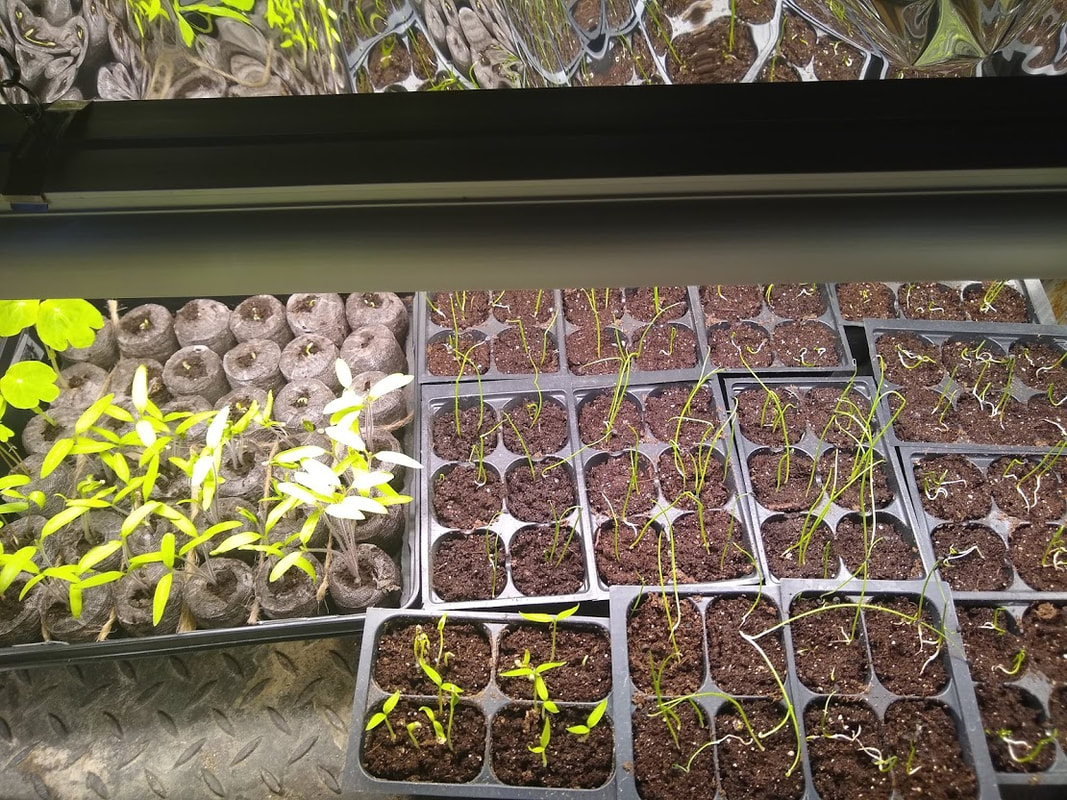The picture above was taken March 10th. You can see some barely-sprouted peppers in the upper left-hand corner. The photo below was taken March 31st:
2020 / 2021 Comparison
Last year, I started my seeds sometime during the last two weeks of February. I took a picture of the seedlings on March 31st, which you can see below:
How much does it cost to run?
The light is on a timer running 9.5 hours per day, sucking a total of 0.2 kWh of juice. Our electricity costs about $0.15 per kWh, so the cost per day to run the light is $0.03. I had the tomatoes and onions under the light for 31 days, for a total cost of $0.93. This seems quite low to me, but the light is rather small (2 ft.) and it is an LED bulb.
I'm not sure how much of a difference the reflective film made, but I used it to get more growing power out of the light. Next year I may do a split test on film vs. no film.
Lastly, I moved my seed-starting setup from an upstairs east-facing window to our damp, dark basement. So far, I haven't lost any seedlings to lack of water (even though I only check them every few days), and I also believe the cooler basement temperature helped the plants grow strong and sturdy.
Other Considerations: Seed Starting Dates
Now that I know how big a difference the light makes, I can adjust my seed starting dates to reflect that head start. Planting later will mean less watering and babysitting after each seedling has matured.
My tomatoes are ready to plant now, but I can't plant them until after our last frost... in May. LOL! So I'm going to be watering these plants for another month and a half!! According to my gardening friends, tomatoes don't get bigger or ripen earlier if they have an extra six weeks to sit indoors, so I haven't done myself or my plants a favor by starting them so early. Next year I'll start the tomato seeds April 1st rather than March 1st, and they should be well ready to transplant in mid-late May.
Onions, as it turns out, don't need that much of a head start, either. The packet says to start them 6-8 weeks before the last frost (so for me, that would mean starting them mid-March to the beginning of April). Next year I will start them in April rather than February.
My pepper plants (started with the tomatoes and onions) are only a fraction of the size of the other plants, since they took far longer to germinate. We'll see how big they are at the end of April, but that is one type of seed that I may still start in February or March.
I'm also learning more about cool-season crops and how to best utilize them in my garden and menu. Beets, carrots and parsnips can be overwintered and harvested in March. Fall-sown spinach is ready to eat in April. Peas and lettuce can be tricky. If you direct-sow them outside, you might get a week or two of harvest before they bolt. By giving them a head start under the light, I can get another week's worth of produce out of the plants. That will be one of my goals for 2022.
That's all I've got for today!
-Bethany










 RSS Feed
RSS Feed





